In a blog for physiotherapists, other health professionals and anyone interested in arts and health, Hannah Dye from Breathe Arts Health Research explains how their innovative dance programme provides an alternative to exercise classes for older adults prescribed strength and balance physiotherapy at Guy’s Hospital, London. Created with patients, the programme is offering people choice in their healthcare pathway and bringing multiple benefits.
Featured photograph: ©Richard Eaton.
Take-home points
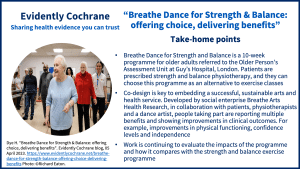
When Wendla, 88, had a fall at home she was referred for strength and balance physiotherapy. She was offered the choice of an exercise physiotherapy group or a dance programme. She selected dance, loved it, made friends, improved her mobility, gained confidence and even reduced carer hours at home. Here she is, talking about it:
.
Breathe Dance for Strength & Balance is a 10-week dance-based physiotherapy programme for adults prescribed strength and balance physiotherapy. Patients eligible for the programme may have had a fall, have a fear of falling, be living with significantly reduced confidence, be living with Parkinson’s, have experienced a stroke, or have a vestibular condition. The programme is delivered by Breathe Arts Health Research (Breathe), in collaboration with Guy’s Older Person’s Assessment Unit (OPAU) and the classes take place at Guy’s hospital in London.
Since 2017, we have had 59 patients take part in Breathe Dance for Strength & Balance (this includes a two-year pause to the service during Covid-19).
Why is this being delivered?
Breathe recognises the need to offer patients choice over their healthcare pathway. By empowering patients and giving them a voice, they are often more likely to engage in the service, which often leads to more sustainable outcomes. Having delivered evidence-based arts programmes within healthcare for over 10 years, Breathe also has experience in seeing the depth of engagement that creative, fun and holistic services can bring to clinical patient outcomes.
Despite this patient group facing many barriers to participation including recurring illness and accessibility challenges to get to Guy’s hospital, we have seen a retention rate of 83% over a 10-week period.
Collaboration at the heart
At Breathe, we believe that co-design is key to creating, evaluating and embedding a clinically effective and sustainable arts and health service and this is truly at the heart of Breathe Dance for Strength & Balance’s six-year existence.
In 2017, Breathe brought together physiotherapists, a specialist dance artist, and patients to develop a creative alternative to traditional physiotherapy for strength and balance. The physiotherapy team’s desire for more patient choice over their healthcare pathway, a tool to address growing waiting lists and introducing alternative approaches to adults requiring regular physiotherapy were the driving force.
Before any delivery began, a scoping and design phase was undertaken so that the 10-week dance programme design would clearly reflect the aims and desired outcomes of the existing exercise class offered at the OPAU. Breathe’s dance artist observed current service provision, gained an understanding of the patient group, and engaged with the physiotherapy team on a regular basis, leading to a 10-week progressive dance programme being designed.
The weekly classes build from chair-based exercises, to supported exercises at the barre, ending with travelling movement in the centre of the room. The difficulty level increases over 10 weeks, with dance exercises becoming more complex physically and removing support aids where possible. Partner and group work is embedded throughout to encourage bonding, increase confidence, and build trust amongst participants. The entire class is accompanied by specifically selected music which aims to motivate patients and add to a creative and fun atmosphere.
“It has been a delight seeing the joy that meaningful exercise can bring to the participants, even better to objectively measure the physical benefits and know that Breathe Dance for Strength and Balance works! Collaborating with Breathe to create a bespoke programme for our older adult population has allowed us to improve patient choice, and engage more people in exercise programmes to support their health and wellbeing, including those who may struggle to engage with more typical exercise classes.”- Carrie-Ann Wood, Clinical Specialist Physiotherapist
To ensure patient safety, Physiotherapists join the class to support patients and one-to-one support in place when required. Our Breathe dance artist is also given relevant information on patients before the start of any class (e.g. any new injury or recent fall) to ensure the delivery is suitable for their ability levels, and is adapted as necessary.
In addition to clinical assessments being conducted at pre- and post-intervention by the team of physiotherapists, we obtain additional qualitative feedback from participants after each 10-week cohort. This has helped refine and adapt the class design to ensure it remains engaging and enjoyable for patients, whilst having the desired impact on clinical outcome measures.
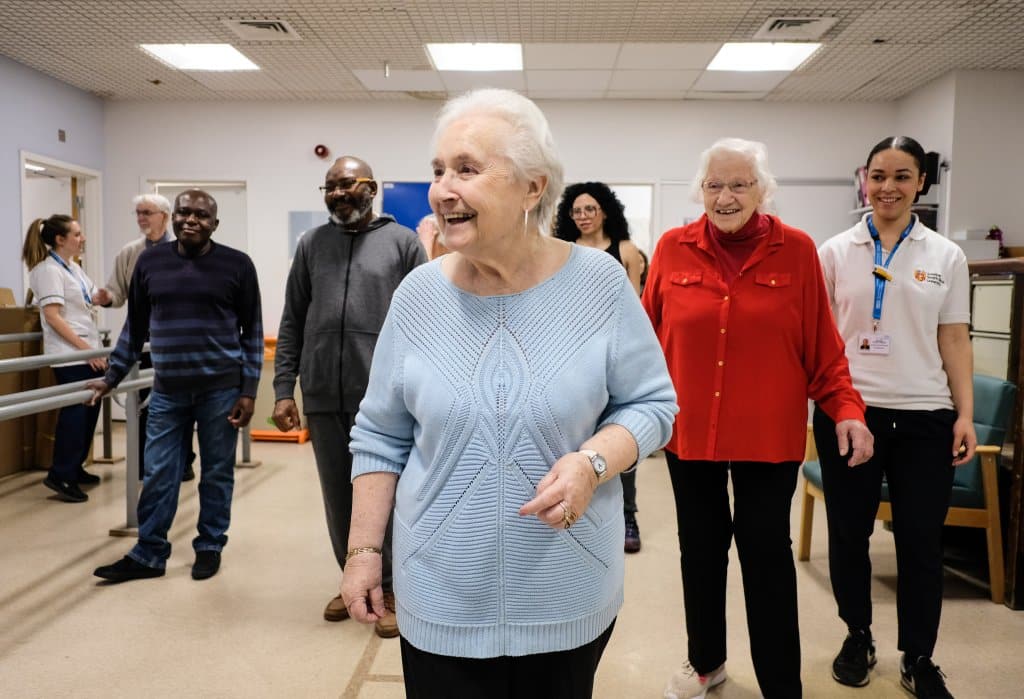
What evidence do we have so far?
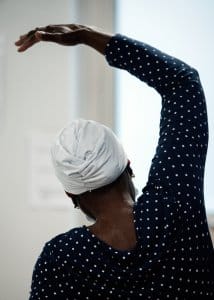
Whilst dance provision for older adults isn’t a new phenomenon, embedding it into mainstream NHS healthcare is. There’s a growing evidence base for the health benefits dance for older adults can bring1,2, in particular for those living with Parkinson’s disease3,4,5. This includes a recent Cochrane Review on Physical exercise for people with Parkinson’s disease 6 (published January 2023) which showed that dance had a moderate beneficial effect on movement symptoms. The review also has the empowering message that different types of exercise may have similar effects – so people can choose what they like to do.*
Guy’s OPAU Physiotherapists have been collating data for Breathe Dance for Strength & Balance between 2019 and 2022, with 59 patients completing full data collection. Their pre- and post-assessment Outcome Measures for Breathe Dance for Strength & Balance mirror those used in their original strength and balance exercise classes and include:
- Timed Up and Go (how long it takes to stand from a chair, walk 3 metres then turn and walk back to the chair and sit down).7
- Gait speed (how long it takes to walk 6 metres at usual walking speed).8
- 180 degree turn (how many steps are taken to change direction through 180 degrees)
- Falls Efficacy Scale International (a subjective outcome asking participants about their confidence in undertaking daily tasks with regards to their fear of falling).9
These measures indicate falls risk potential and are markers of physical function.
Of the data we have so far, we know that:
- 64% of patients reduced their Timed Up and Go by 5.18 seconds (looking to improve by more than 4.85 seconds for a minimal clinically detectable change)
- 74% of patients increased their gait speed by 0.23 metres/second (aiming to increase by 0.10m/s for a minimal clinically detectable change)
- 42% of patients reduced their 180 degree turn by 2.33 steps with the average number of steps 3.6 for all patients at the end of the classes (fewer than 4 steps indicating a reduced fall risk)
- 61% of patients reduced their fear of falling by 11.2 points (with a change of more than 8.6 points representing a minimal clinical detectable change)
To date, there have been no unwanted effects from the programme.
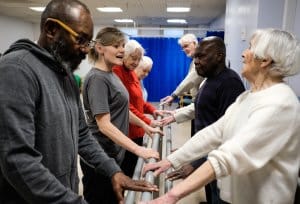
Capturing qualitative data in addition to clinical measures has been key to measure the impact of the programme. From this data, we know that:
- 92% reporting it had a positive impact on their experience of the healthcare environment.
- 100% of patients reported it was an enjoyable experience, many noting the encouraging group atmosphere reduced feelings of loneliness and resulted in them making new friends.
“When one finds themself in a chair day in, day out. It’s amazing to be with people, laughing.”- Participant
“It made me bond with people I did not know, which is very frightening for me usually.” – Participant
Upon completing the 10 weeks, participants also reported an improvement in their independence, confidence, and life skills:
“I don’t use my crutch or stick at home now, only when I go out. I have improved so much.” – Participant
“I always had terrible sciatica. I always loved to go out, believe it or not, to the shops and do my own shopping, but I just couldn’t do it. After Breathe Dance… if it stays like this, I will be able to do my own shopping.” – Participant
Future ambitions
Whilst our findings to date have been encouraging, presenting positive outcome data on patients’ development both physically and psychosocially, we need to continue to build on our evidence.
Our ambition is to continue embedding Breathe Dance for Strength & Balance as a clinical service within Guy’s OPAU, and work to establish whether dance is at least as effective as their existing and ongoing strength and balance exercise classes. A comparison study is underway to help us make the case to permanently incorporate Breathe Dance for Strength & Balance as an intervention within the OPAU portfolio for older adults at risk of falls.
By contributing to the evidence base around dance for older adults, we hope it will allow us to develop more dance-based physiotherapy programme models which can be scaled up into new locations.
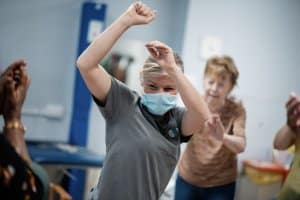
Patient experiences of Breathe Dance
To understand the impact the service has had, we invite you to enjoy another patient story via the short film below. This one follows the experiences of Alfred – you can see him in action in the class and hear directly from him on how Breathe Dance for Strength & Balance has impacted him:
.
Find out more:
- Breathe Arts Health Research
- Breathe Dance for Strength & Balance
- Guy’s Older Person Assessment Unit: https://www.guysandstthomas.nhs.uk/our-services/ageing-and-health Referrals: If you are interested in the services offered and live within the Boroughs of Lambeth and Southwark please get in touch with your GP for a referral to the Physiotherapy Department in Guy’s Older Person’s Assessment Unit.
- Breathe Dance for Strength & Balance is made possible thanks to the supporters of Guy’s and St Thomas’ Charity
*Find out more in this blog: Physical exercise for people with Parkinson’s: do what you enjoy
Join in the conversation with @BreatheAHR @hannahjdye @CochraneUK or leave a comment on the blog.
Please note, we cannot give specific medical advice. We do not publish comments that link to individual pages requesting donations or to commercial sites, or appear to endorse commercial products. We welcome diverse views and encourage discussion. However, we ask that comments are respectful. We reserve the right to not publish any we consider offensive. Cochrane UK does not fact check – or endorse – readers’ comments, including any treatments mentioned.
Hannah Dye has nothing to disclose.

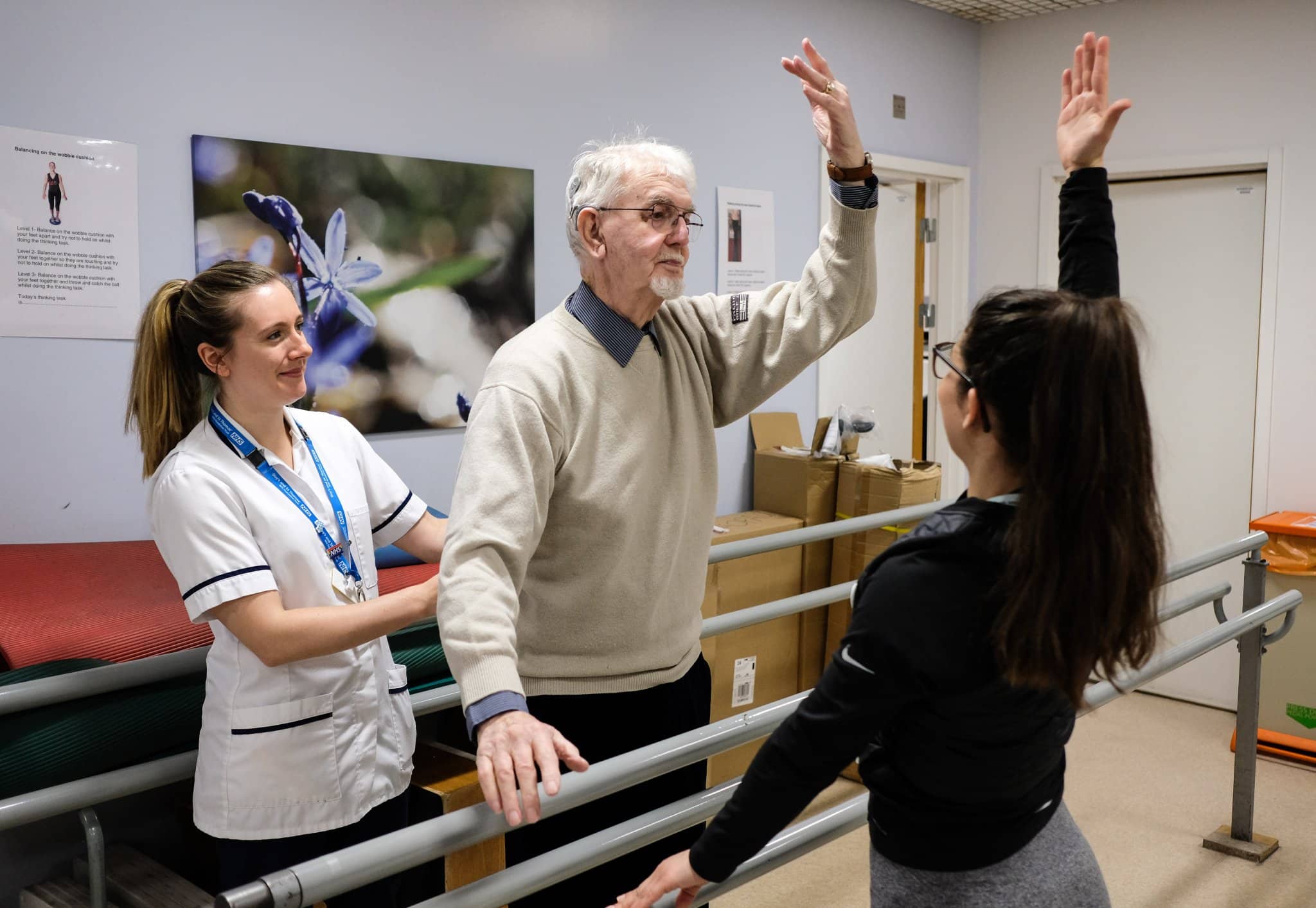

Awwww…I want to dance with Wendla and Alfred! Well done to the team leading this and everyone participating!